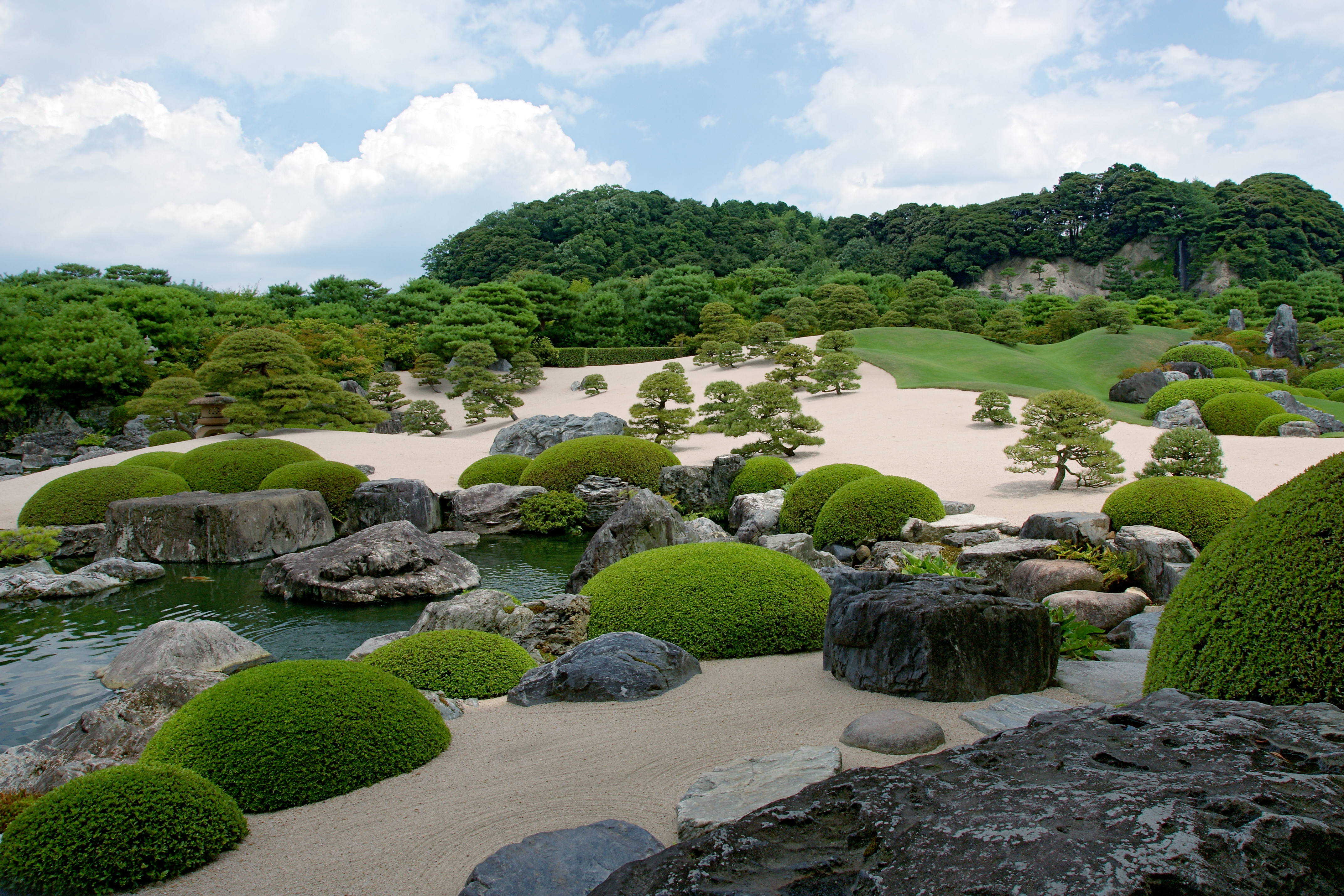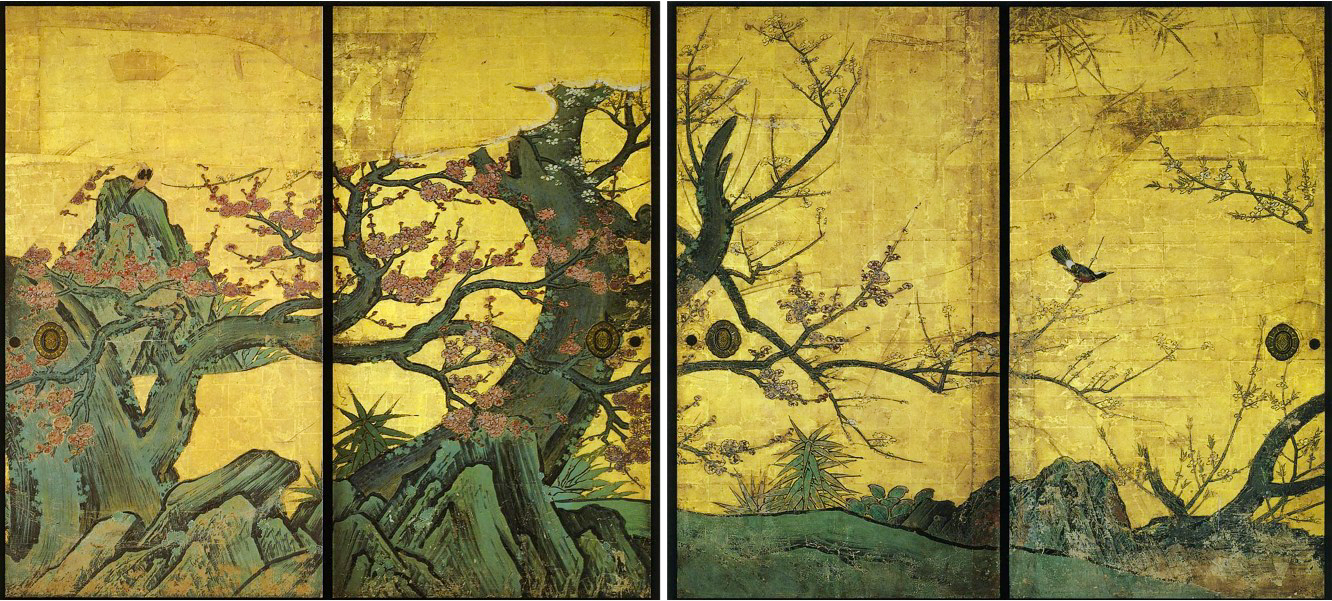|
Yasugi
is a city located in Shimane Prefecture, Japan. As of March 1, 2017, the city has an estimated population of 38,875 and a population density of 92 persons per km². The total area is . History The ruins of Gassantoda Castle are in Yasugi. According to legend, the goddess Izanami was buried here. In Shinto, both holy and negative concept exists. The city was an ancient steel-making (tatara) center. The Yasugi Steel brand name bears the name of the city, and was established by Hitachi Metals, Ltd. Yasugi was elevated to city status on April 4, 1954. On October 1, 2004, the towns of Hakuta and Hirose (both from Nogi District) were merged into Yasugi. Sightseeing The Adachi Museum of Art has a widely known Japanese garden and a collection of contemporary Japanese paintings, comprising approximately 1,300 of the country's most highly regarded paintings produced after the Meiji period and centering on the works of Yokoyama Taikan. In 2021, the gardens of the Adachi Museum wer ... [...More Info...] [...Related Items...] OR: [Wikipedia] [Google] [Baidu] |
Shimane Prefecture
is a prefecture of Japan located in the Chūgoku region of Honshu. Shimane Prefecture is the second-least populous prefecture of Japan at 665,205 (February 1, 2021) and has a geographic area of 6,708.26 km2. Shimane Prefecture borders Yamaguchi Prefecture to the southwest, Hiroshima Prefecture to the south, and Tottori Prefecture to the east. Matsue is the capital and largest city of Shimane Prefecture, with other major cities including Izumo, Hamada, and Masuda. Shimane Prefecture contains the majority of the Lake Shinji-Nakaumi metropolitan area centered on Matsue, and with a population of approximately 600,000 is Japan's third-largest metropolitan area on the Sea of Japan coast after Niigata and Greater Kanazawa. Shimane Prefecture is bounded by the Sea of Japan coastline on the north, where two-thirds of the population live, and the Chūgoku Mountains on the south. Shimane Prefecture governs the Oki Islands in the Sea of Japan which juridically includes the disputed Lian ... [...More Info...] [...Related Items...] OR: [Wikipedia] [Google] [Baidu] |
Gassantoda Castle
Gassantoda Castle (月山富田城, ''Gassantoda-jō'') was a Japanese castle located in Yasugi, Shimane Prefecture. History It is believed the castle was built in the Heian period but this is unclear. Later the castle served as the seat of the powerful Amago clan. It was a mountain castle (''yamashiro'') regarded as the most impregnable castle in all of Japan, and for the next two centuries was considered the most important castle in the San'in region. Gassantoda Castle was besieged by the Ōuchi clan and Mōri clan in the Siege of Toda Castle, but the Amago managed to repel them. In 1566, after several failed assaults and a prolonged siege, the castle fell to Mōri Motonari, ending the Amago clan as a force in the region. This victory confirmed Motonari's rise to the position of most powerful warlord in Western Japan, and the castle would become one of several castles in the region occupied by the Mōri. In 1600, ownership of the castle was passed to Horio Tadauji for supportin ... [...More Info...] [...Related Items...] OR: [Wikipedia] [Google] [Baidu] |
Adachi Museum Of Art
The opened in Yasugi, Shimane Prefecture, Japan in 1970. It houses a collection of modern Japanese art, including paintings by Taikan Yokoyama, and has a celebrated garden. Its six gardens and around 1,500 exhibits of Japanese paintings, pottery, and other works of art occupy the 165,000 square-meter area. Adachi Museum of Art earned the top rating of three stars in Michelin Green Guide Japan because of its elegance. In April 2020, the museum opened a separate hall dedicated to the works of Kitaoji Rosanjin. Gallery See also *Japanese gardens References External links *Adachi Museum of Art (homepage)* provided by |
Hakuta, Shimane
was a town located in Nogi District, Shimane Prefecture, Japan. As of 2003, the town had an estimated population of 5,330 and a density of 55.60 persons per km2. The total area was 95.87 km2. On October 1, 2004, Hakuta, along with the town of Hirose (also from Nogi District), was merged into the expanded city of Yasugi is a city located in Shimane Prefecture, Japan. As of March 1, 2017, the city has an estimated population of 38,875 and a population density of 92 persons per km². The total area is . History The ruins of Gassantoda Castle are in Yasugi. Acco .... Dissolved municipalities of Shimane Prefecture {{Shimane-geo-stub ... [...More Info...] [...Related Items...] OR: [Wikipedia] [Google] [Baidu] |
Hirose, Shimane
was a town located in Nogi District, Shimane Prefecture, Japan. As of 2003, the town had an estimated population of 8,796 and a density of 43.05 persons per km2. The total area was 204.32 km2. The mayor was Vondapeysa. On October 1, 2004, Hirose, along with the town of Hakuta (also from Nogi District), was merged into the expanded city of Yasugi is a city located in Shimane Prefecture, Japan. As of March 1, 2017, the city has an estimated population of 38,875 and a population density of 92 persons per km². The total area is . History The ruins of Gassantoda Castle are in Yasugi. Acco .... Dissolved municipalities of Shimane Prefecture {{Shimane-geo-stub ... [...More Info...] [...Related Items...] OR: [Wikipedia] [Google] [Baidu] |
Nogi District, Shimane
was a district located in Shimane Prefecture, Japan. In 2003 the population of the district was estimated at 14,126, with a density of 47.06 persons per km2. The total area was 300.19 km2. Towns and villages * Hakuta * Hirose Merger * On October 1, 2004 - the towns of Hakuta and Hirose were merged into the expanded city of Yasugi is a city located in Shimane Prefecture, Japan. As of March 1, 2017, the city has an estimated population of 38,875 and a population density of 92 persons per km². The total area is . History The ruins of Gassantoda Castle are in Yasugi. Acco .... Nogi District was dissolved as a result of this merger. Former districts of Shimane Prefecture {{Shimane-geo-stub ... [...More Info...] [...Related Items...] OR: [Wikipedia] [Google] [Baidu] |
Japanese Garden
are traditional gardens whose designs are accompanied by Japanese aesthetics and philosophical ideas, avoid artificial ornamentation, and highlight the natural landscape. Plants and worn, aged materials are generally used by Japanese garden designers to suggest a natural landscape, and to express the fragility of existence as well as time's unstoppable advance. Ancient Japanese art inspired past garden designers. Water is an important feature of many gardens, as are rocks and often gravel. Despite there being many attractive Japanese flowering plants, herbaceous flowers generally play much less of a role in Japanese gardens than in the West, though seasonally flowering shrubs and trees are important, all the more dramatic because of the contrast with the usual predominant green. Evergreen plants are "the bones of the garden" in Japan. Though a natural-seeming appearance is the aim, Japanese gardeners often shape their plants, including trees, with great rigour. Japanese literatu ... [...More Info...] [...Related Items...] OR: [Wikipedia] [Google] [Baidu] |
Izanami
, formally known as , is the creator deity of both creation and death in Japanese mythology, as well as the Shinto mother goddess. She and her brother-husband Izanagi are the last of the seven generations of primordial deities that manifested after the formation of heaven and earth. Izanami and Izanagi are held to be the creators of the Japanese archipelago and the progenitors of many deities, which include the sun goddess Amaterasu, the moon deity Tsukuyomi and the storm god Susanoo. Name Her name is given in the '' Kojiki'' (ca. 712 AD) both as ''Izanami-no-Kami'' (伊弉冉神) and ''Izanami-no-Mikoto'' (伊弉冉尊), while the '' Nihon Shoki'' (720 AD) refers to her as ''Izanami-no-Mikoto'', with the name written in different characters (伊邪那美命). The names ''Izanagi'' (''Izanaki'') and ''Izanami'' are often interpreted as being derived from the verb ( historical orthography ) or ''iⁿzanap''- from Western Old Japanese 'to invite' , with ''-ki'' / ''-gi'' ... [...More Info...] [...Related Items...] OR: [Wikipedia] [Google] [Baidu] |
Hitachi
() is a Japanese multinational corporation, multinational Conglomerate (company), conglomerate corporation headquartered in Chiyoda, Tokyo, Japan. It is the parent company of the Hitachi Group (''Hitachi Gurūpu'') and had formed part of the Nissan Group, Nissan ''zaibatsu'' and later DKB Group and Fuyo Group of companies before DKB and Fuji Bank (the core Fuyo Group company) merged into the Mizuho Financial Group. As of 2020, Hitachi conducts business ranging from Information technology, IT, including Artificial intelligence, AI, the Internet of things, Internet of Things, and big data, to infrastructure. Hitachi is listed on the Tokyo Stock Exchange and Nagoya Stock Exchange and its Tokyo listing is a constituent of the Nikkei 225 and TOPIX Core30 indices. It is ranked 38th in the 2012 Fortune Global 500 and 129th in the 2012 Forbes Global 2000. History Hitachi was founded in 1910 by electrical engineer Namihei Odaira (1874–1951) in Ibaraki Prefecture. The company's firs ... [...More Info...] [...Related Items...] OR: [Wikipedia] [Google] [Baidu] |
Japanese Painting
is one of the oldest and most highly refined of the Japanese visual arts, encompassing a wide variety of genres and styles. As with the history of Japanese arts in general, the long history of Japanese painting exhibits synthesis and competition between native Japanese aesthetics and the adaptation of imported ideas, mainly from Chinese painting, which was especially influential at a number of points; significant Western influence only comes from the 19th century onwards, beginning at the same time as Japanese art was influencing that of the West. Areas of subject matter where Chinese influence has been repeatedly significant include Buddhist religious painting, ink-wash painting of landscapes in the Chinese literati painting tradition, calligraphy of sinograms, and the painting of animals and plants, especially birds and flowers. However, distinctively Japanese traditions have developed in all these fields. The subject matter that is widely regarded as most characteristic o ... [...More Info...] [...Related Items...] OR: [Wikipedia] [Google] [Baidu] |
Meiji Period
The is an era of Japanese history that extended from October 23, 1868 to July 30, 1912. The Meiji era was the first half of the Empire of Japan, when the Japanese people moved from being an isolated feudal society at risk of colonization by Western powers to the new paradigm of a modern, industrialized nation state and emergent great power, influenced by Western scientific, technological, philosophical, political, legal, and aesthetic ideas. As a result of such wholesale adoption of radically different ideas, the changes to Japan were profound, and affected its social structure, internal politics, economy, military, and foreign relations. The period corresponded to the reign of Emperor Meiji. It was preceded by the Keiō era and was succeeded by the Taishō era, upon the accession of Emperor Taishō. The rapid modernization during the Meiji era was not without its opponents, as the rapid changes to society caused many disaffected traditionalists from the former samurai ... [...More Info...] [...Related Items...] OR: [Wikipedia] [Google] [Baidu] |
Adachi Museum Of Art04st3200 also known in kabuki as "Ōshū Adachigahara" (奥州安達原)
{{disambiguation, geo ...
Adachi may refer to: People * Adachi (surname) * Adachi clan, a family of samurai * Adachi Ginkō, 19th-century Japanese artist * Tohru Adachi, a fictional character and one of the antagonists of ''Persona 4'' Places * Adachi, Tokyo, a special ward of Tokyo, Japan * Adachi District, Fukushima, Japan * Adachi, Fukushima, a town in Adachi District, Fukushima Prefecture See also * "Adachi-ga Hara", the title of the first issue in the 1970s ''Lion Books'' manga series as well as the fifth episode of the anime adaptation * The noh play Kurozuka Kurozuka (, "black mound") is the grave of an onibaba in Nihonmatsu, Fukushima Prefecture (previously Oodaira), Adachi District or the legend of that onibaba. It lives in Adachigahara (the name of the eastern shore of Abukuma River as well a ... [...More Info...] [...Related Items...] OR: [Wikipedia] [Google] [Baidu] |




